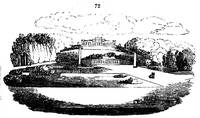306. The gardens of Schonbrunn were laid out in the French style in 1696, from the design of the celebrated architect Fischer, of Erlach; and they were enlarged and embellished during the reign of Francis I., from 1775 to 1780, after the plans of Steck-hoven, a Dutch artist. The palace is an immense building, with walls full of windows, but without much grandeur of style. The garden embraces it on three sides; to the right and left are private flower-gardens and hothouses, for the exclusive enjoyment of the imperial family. The principal garden, which is open to every one, at all times throughout the year, covers a level space, which extends 500 feet from the front of the palace to the base of a hill, on the summit of which, directly opposite the palace, is an ornamental building called the Gloriette (fig. 72.), which forms a conspicuous feature from most parts of the garden and of the surrounding country. The level part of the garden in composed of intersecting clipped avenues and alleys, and forms a whole, grand though formal. The most conspicuous ornaments of these gardens are the Gloriette; the artificial ruins of a Roman building; an obelisk; a fountain richly orna-mented, in compliment to the name of Schonbrunn (beautiful fountain); and a monument to the memory of the Queen of Naples. The minor ornaments are jets d'eau, and between thirty and forty marble statues of the heathen gods and goddesses. There is a menagerie in the form of a circle, having in the centre an octagon pavilion, from the windows of which the animals are seen in their different dens, in the building which forms the circumference to the circle. All the alleys, avenues, and vistas, in these gardens, are bordered with hornbeams, which are clipped twice a year, to the height of fifty feet. The effect is a great sameness of vegetation. The botanic garden excels all others in Austria in respect to the quantity, rarity, and size of the plants in the hothouses. On the other side of the hill containing the Gloriette is a Tyrolese cottage constructed of wood, and serving as a cow-house and dairy. On the whole, these gardens are inferior to those of Peterhoff and Versailles in respect to fountains, and to those of Sans Souci and Ludovisi for statues and antiques; but for simple massive grandeur, for shade and verdure, and for all the more simple beauties of the ancient style, they are, we believe, superior to any gardens now existing in Europe.

